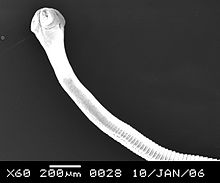Raillietina tetragona
| Raillietina tetragona | |
|---|---|
 |
|
| R. tetragona anterior part | |
| Scientific classification | |
| Kingdom: | Animalia |
| Phylum: | Platyhelminthes |
| Class: | Cestoda |
| Order: | Cyclophyllidea |
| Family: | Davaineidae |
| Genus: | Raillietina |
| Species: | tetragona |
| Binomial name | |
|
Raillietina tetragona Molin, 1858 |
|
Raillietina tetragona (synonym Taenia tetragona Molin) is a parasitic tapeworm belonging to the class Cestoda. It is a cosmopolitan helminth of the small intestine of pigeon, chicken and guinea fowl, and is found throughout the world.
It is a very typical of cestode with striking resemblance to other species of Raillietina. Its identifying features are, therefore, mainly on the neck and scolex structures. In addition, it is relatively large, and requires ant as intermediate host to complete its life cycle.
R. tetragona is the largest among avian tapeworms, measuring up to 30 cm in length and 1-1.5 cm in breadth. It is whitish in colour, highly elongated, dorso-ventrally flattened, and entirely covered with a tegument. The body is divisible into the head region called 'scolex', followed by an unsegmented 'neck', and then by highly segmented body proper called strobila. The strobila is composed of a series of ribbon-like body segments called proglottids, gradually enlarging from the anterior end towards the posterior. The scolex bears an apical rounded rostellum, which is armed with 100 minute hooks, arranged in single row. This is surrounded by four suckers which are lined with 5-6 rows of spines. The most important diagnostic characters in comparison to other species are oval scolex and suckers, with relatively elongated neck.
...
Wikipedia
